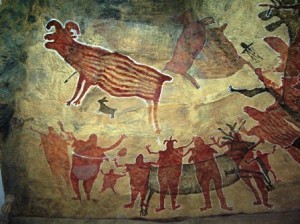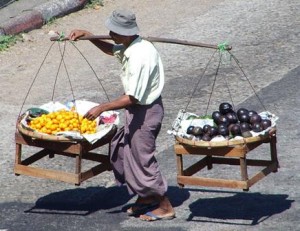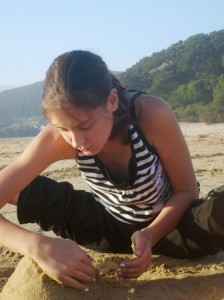Making Work Feel Like Vacation: Destination Postcards Exercise
Much of the time we muddle through. Okay, maybe not you, but those around you. 😉 We show up to work, we grind through the day, glancing at the clock that’s embedded in our computers, smartphones, and burned into our psyche. Sometimes we’re lucky enough to get “in the zone” where we become deeply engaged in something, perhaps writing an article or code, talking with a customer or colleague, or crafting whatever it is we craft. In those moments and in our “free time” we seldom feel as though we’re grinding through. After all, we are excited to meet the weekend and few people ever grumble about being on vacation; quite the opposite. So, how can we find that vacation feeling while we ARE muddling through our busy lives?
Our Minds are Ruled by Two Competing Systems
The key is to leverage your brain’s natural abilities to be rational and to be emotional, two things that are often at odds with one another. In the book, Switch: How to Change Things when Change is Hard, the authors reveal that psychologists have discovered our minds are ruled by two sometimes competing systems – the rational mind (the rider) and the emotional mind (the elephant). Switch is a great book and I recommend you read it. It is a great companion to Chapter 13: Taking Flight, in The Experience Design Blueprint. Change is difficult and no matter where you sit in the organization you need to become a master of it.
Destination Postcards Exercise
Switch inspired me to create a tool I use for my own businesses and with clients. I call the tool the Destination Postcards exercise and I know it can help you, too. I’ve shared the steps here as well as a visual reminder so you can be more deliberate about creating the future you’d like to see unfold AND make it feel more like a vacation.
“If you don’t know where you are going, any path will take you there.” – Sioux Proverbs
Step 1: Envision Great Possibilities
Our rational mind appreciates the certainty of the path ahead; we want to know where vacation will be. As in planning a vacation, the first step in the destination postcards exercise is to actually decide where you want to go. Every business, non-profit, and governmental organization has multiple destinations; these are the destination postcard categories. The list that follows is not exhaustive. Choose the categories important to the future of your organization. Be creative and be aware of blind spots while choosing.
Categories for Destination Postcards:
- technology
- organizational
- financial
- customer
- brand
- communications
- community
- competitive
- products and services
- recognition
- other?
Step 2: Prioritize Categories
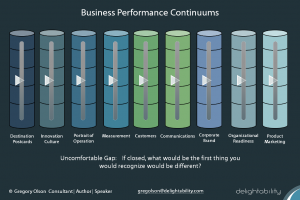 Not all categories have the same importance. It really does depend on the type of organization, its current state, as well as the competitive and customer environment. See the related article on business performance continuums to assess the current and future state of the organization across nine dimensions. Once your categories are selected, it can be useful to prioritize them by using a convention common to prioritizing features in product development. Rank each category on whether it is a MD (must do), SD (should do), and CD (could do) item for the organization.
Not all categories have the same importance. It really does depend on the type of organization, its current state, as well as the competitive and customer environment. See the related article on business performance continuums to assess the current and future state of the organization across nine dimensions. Once your categories are selected, it can be useful to prioritize them by using a convention common to prioritizing features in product development. Rank each category on whether it is a MD (must do), SD (should do), and CD (could do) item for the organization.
As you prioritize, free yourself of resource constraints. After all, resources can change or even be creatively worked around. It is most important to think about the expected impact to the organization for each of the categories. Again, be careful of blind spots and be mindful of your various stakeholders. See the related article Customer Schmustomer: Audience Schmaudience.
Step 3: Make a Statement About How the Future Feels
 By establishing the categories that are most important to the organization, you’ve appealed to rationale mind (the rider). In Switch vernacular, you’ve directed the rider by pointing to the destination. This is necessary, but not sufficient. Next, you’ll want to appeal to the emotional elephant; you’ll not reach your destination without the elephant.
By establishing the categories that are most important to the organization, you’ve appealed to rationale mind (the rider). In Switch vernacular, you’ve directed the rider by pointing to the destination. This is necessary, but not sufficient. Next, you’ll want to appeal to the emotional elephant; you’ll not reach your destination without the elephant.
To do this, write a statement about the desired future state for each category. How will you know you’ve arrived? What will you see as different and how will that make you feel? You can either write a statement or add bullets to show some detail about the desired future state. If this were a vacation you might write something like “feel my toes in the warm sand” or “be able to ponder the ancient Incan empire from atop Machu Picchu” or [insert most excellent vacation experience here]. If we imagine what it is like to be there, our vacation will be more thoughtful and we’ll be more present once we arrive. This is true of vacation and in business. Here is an example for your business using the category, Recognition. Once we’ve arrived at the destination we might feel the following:
- be able to credibly apply for “most green citizen” award
- media and partners are recognizing our organization’s thoughtful work
- awards and framed articles hang on trophy wall in lobby
- our products are labeled with the Cradle to Cradle Certification
- we have more twitter followers than Edward Snowden
Step 4: Empower a Good Story
At this stage, you’ve created a narrative for the organization’s future. You’ll have more clarity yourself, and if you did this exercise with colleagues, you’re better aligned to a common future. You can reference the destination postcards as you build your strategic plan and tell stories about the future.
Go even further by creating physical postcards that can be handed out to employees, partners, and other stakeholders. On one side, make a visual to represent the category; on the other, list the milestones you’ll achieve along the way to reaching that destination. These physical cards can be seen, touched, passed around, referenced and updated periodically. This can be very motivating for all story tellers of the organization. It can also keep people (yourself included) on the right path.
Step 5: Ah, The Path
The Destination Postcards Exercise is a critical tool, among others, to shape and inform a strategic plan. I usually do this exercise with a CEO, executive director, or early stage entrepreneur, but it can be easily extended to include a larger team. I’ve sparked good dialogue among board members using the same exercise in non-profit organizations.
The exercise can be an inclusive process that enables people to get on the same page, something usually overlooked by the committees that shape plans. Imagine the natural forces within our minds that sometimes oppose each other, instead working in harmony. This is the harmony we feel while on a good vacation. And, now imagine all of those minds on your team working better together toward a common future. Oh, the possibilities.
Remember, business planning like vacation is better with postcards. I hope you enjoy your next one. If you are a consultant (internal or external), try using this tool with your organization (clients) and watch attitudes, engagement, and positive outcomes soar. Your destination awaits you; happy travels.
about the author
 Gregory Olson’s latest book is L’ impossi preneurs: A Hopeful Journey Through Tomorrow, a light-hearted and deadly serious book about a brighter future where we live more meaningful lives, governments invest in people and sustainable progress, and technology serves humans. This book challenges each of us to think differently, spark our own conversations, and play a role in nudging the world forward to create a better future for all. Find it at Amazon, Bokus, or order it from your local bookstore.
Gregory Olson’s latest book is L’ impossi preneurs: A Hopeful Journey Through Tomorrow, a light-hearted and deadly serious book about a brighter future where we live more meaningful lives, governments invest in people and sustainable progress, and technology serves humans. This book challenges each of us to think differently, spark our own conversations, and play a role in nudging the world forward to create a better future for all. Find it at Amazon, Bokus, or order it from your local bookstore.
 Greg also authored The Experience Design Blueprint, a book about designing better experiences and then making them come true. Exercises and mental models in the book will build your confidence and competence in envisioning better possibilities and then making them come true, whether you are working alone or alongside a team. Chapters in the book that especially pertain to this article include:
Greg also authored The Experience Design Blueprint, a book about designing better experiences and then making them come true. Exercises and mental models in the book will build your confidence and competence in envisioning better possibilities and then making them come true, whether you are working alone or alongside a team. Chapters in the book that especially pertain to this article include:
- Chapter 8: The Promise Delivery System
- Chapter 11: Barriers to Innovation and Overcoming the Wall
- Chapter 12: The Three Psychological Zones
- Chapter 13: Taking Flight
- Chapter 14: The World of Work Has Changed
- Chapter 15: From Arg to Aha!
 Gregory Olson founded strategy and design firm Delightability, LLC. with the belief that if you delight customers then success will follow. He believes that we all have the potential to do better, as individuals, organizations, and communities, but sometimes we need a little help. Gregory also serves as a volunteer board member for Oikocredit Northwest, a support association for social and impact investor, Oikocredit International.
Gregory Olson founded strategy and design firm Delightability, LLC. with the belief that if you delight customers then success will follow. He believes that we all have the potential to do better, as individuals, organizations, and communities, but sometimes we need a little help. Gregory also serves as a volunteer board member for Oikocredit Northwest, a support association for social and impact investor, Oikocredit International.


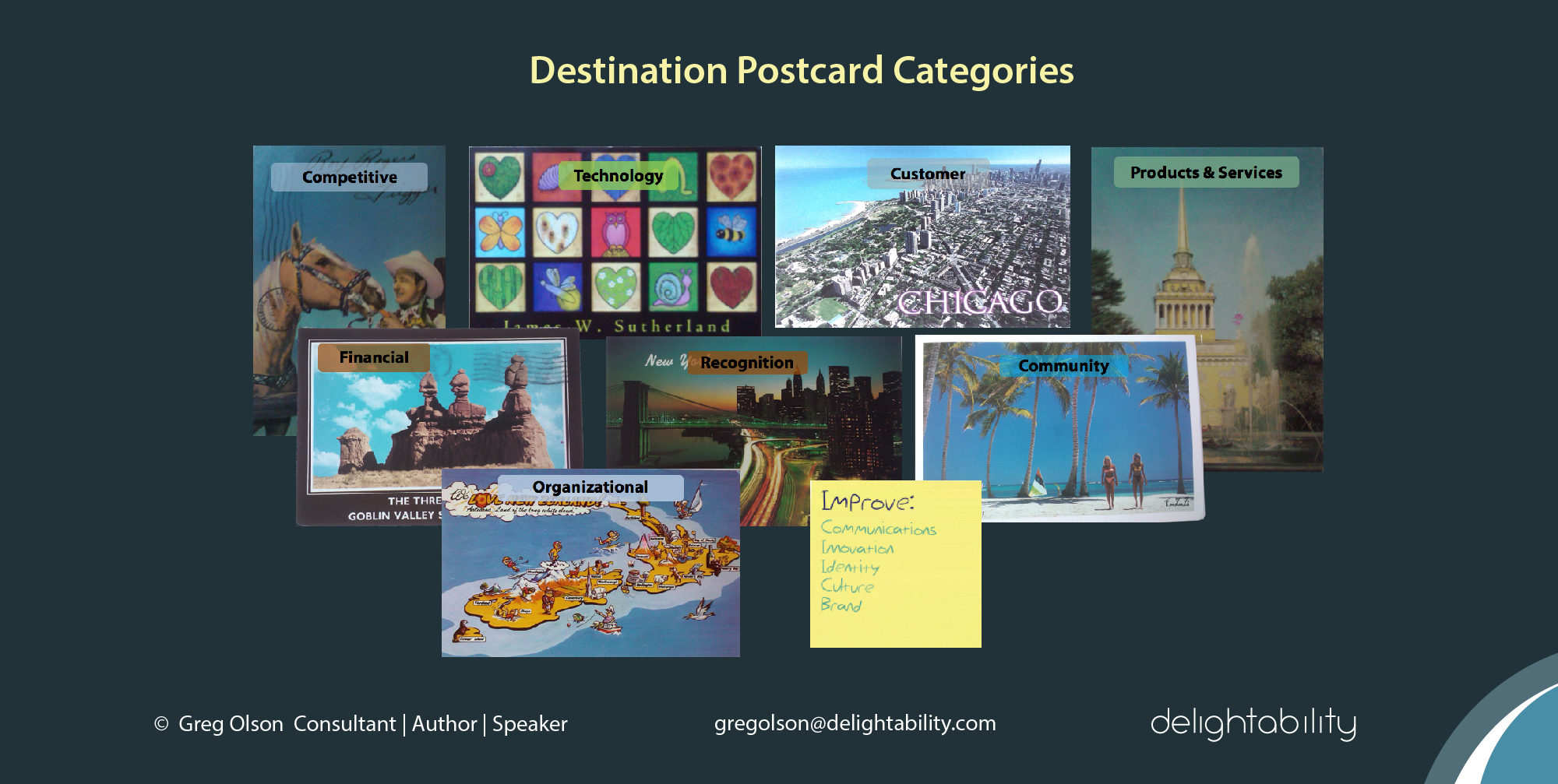

 Gregory Olson founded strategy and design firm Delightability, LLC. with the belief that if you delight customers then success will follow. He believes that we all have the potential to do better, as individuals, organizations, and communities, but sometimes we need a little help. Gregory also serves as a volunteer board member for
Gregory Olson founded strategy and design firm Delightability, LLC. with the belief that if you delight customers then success will follow. He believes that we all have the potential to do better, as individuals, organizations, and communities, but sometimes we need a little help. Gregory also serves as a volunteer board member for 







 In Adelaide, South Australia, RipeNear.Me, provides a platform for people to connect directly with growers or find food on public land. The site has the promise of eliminating waste at the source and even encourages more locally grown sustainable food in backyards, front yards, balconies, rooftops, vacant blocks, and other empty urban spaces. It provides a platform for growers to give away excess food or even establish a profitable ecosystem or micro farm. Join registered users in cities in 16 countries on 5 continents.
In Adelaide, South Australia, RipeNear.Me, provides a platform for people to connect directly with growers or find food on public land. The site has the promise of eliminating waste at the source and even encourages more locally grown sustainable food in backyards, front yards, balconies, rooftops, vacant blocks, and other empty urban spaces. It provides a platform for growers to give away excess food or even establish a profitable ecosystem or micro farm. Join registered users in cities in 16 countries on 5 continents.  In the city of Galdakao, in the Basque town in Northern Spain, the Association of Volunteers of Galdakao, under leadership from Alvaro Saiz established the Solidarity Fridge. The communal refrigerator sits on a city sidewalk with a fence around it. Anybody in the town of 30,000, can deposit food or help themselves to what’s inside. Simply stop by and grab what you need. Mayor Ibon Uribe, upon hearing the idea, immediately supported it with a small budget to get it started and to sustain its operation. A physical refrigerator in plain view is especially valuable for those without internet access or smartphones. The group wants to build a network of communal refrigerators and invites others to join.
In the city of Galdakao, in the Basque town in Northern Spain, the Association of Volunteers of Galdakao, under leadership from Alvaro Saiz established the Solidarity Fridge. The communal refrigerator sits on a city sidewalk with a fence around it. Anybody in the town of 30,000, can deposit food or help themselves to what’s inside. Simply stop by and grab what you need. Mayor Ibon Uribe, upon hearing the idea, immediately supported it with a small budget to get it started and to sustain its operation. A physical refrigerator in plain view is especially valuable for those without internet access or smartphones. The group wants to build a network of communal refrigerators and invites others to join. 
 Solidarity Fridge was inspired by a larger initiative that began in Germany, namely, Foodsharing.de. Using the website, individuals who have food that is still good but cannot use it, can connect to people who need food. But, it isn’t only individuals. Supermarkets and bakers are participating in over 240 German cities along with 41,000 people. In the first year of operation the website received over 1 million visitors. People don’t have the stigma of registering with a food bank and then subsequently waiting in line. It is more dignified. Volunteers known as Foodsavers are happy to do their part in picking up food from bakers, etc., saving food from waste, and making the world a little better place.
Solidarity Fridge was inspired by a larger initiative that began in Germany, namely, Foodsharing.de. Using the website, individuals who have food that is still good but cannot use it, can connect to people who need food. But, it isn’t only individuals. Supermarkets and bakers are participating in over 240 German cities along with 41,000 people. In the first year of operation the website received over 1 million visitors. People don’t have the stigma of registering with a food bank and then subsequently waiting in line. It is more dignified. Volunteers known as Foodsavers are happy to do their part in picking up food from bakers, etc., saving food from waste, and making the world a little better place. 







